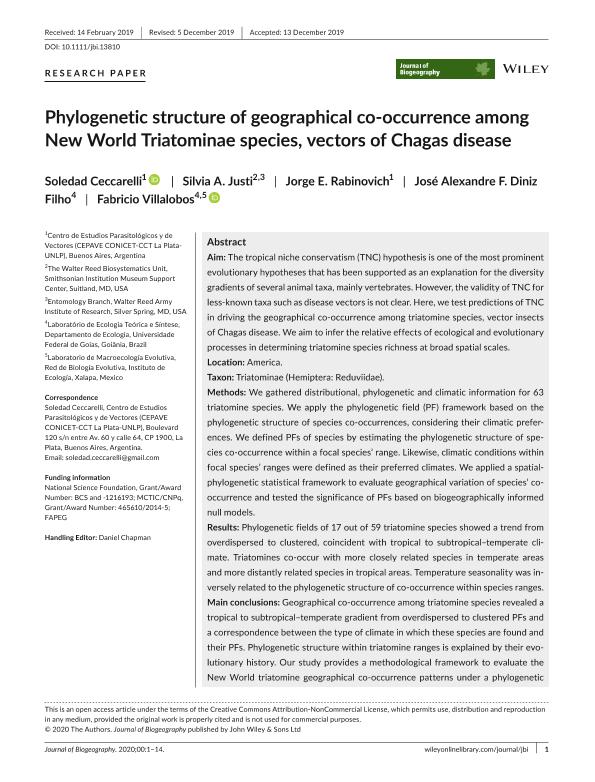Artículo
Phylogenetic structure of geographical co-occurrence among New World Triatominae species, vectors of Chagas disease
Ceccarelli, Soledad ; Justi, Silvia A.; Rabinovich, Jorge Eduardo
; Justi, Silvia A.; Rabinovich, Jorge Eduardo ; Diniz Filho, José Alexandre F.; Villalobos, Fabricio
; Diniz Filho, José Alexandre F.; Villalobos, Fabricio
 ; Justi, Silvia A.; Rabinovich, Jorge Eduardo
; Justi, Silvia A.; Rabinovich, Jorge Eduardo ; Diniz Filho, José Alexandre F.; Villalobos, Fabricio
; Diniz Filho, José Alexandre F.; Villalobos, Fabricio
Fecha de publicación:
06/2020
Editorial:
Wiley Blackwell Publishing, Inc
Revista:
Journal of Biogeography
ISSN:
0305-0270
e-ISSN:
1365-2699
Idioma:
Inglés
Tipo de recurso:
Artículo publicado
Clasificación temática:
Resumen
The tropical niche conservatism (TNC) hypothesis is one of the most prominent evolutionary hypotheses that has been supported as an explanation for the diversity gradients of several animal taxa, mainly vertebrates. However, the validity of TNC for less-known taxa such as disease vectors is not clear. Here, we test predictions of TNC in driving the geographical co-occurrence among triatomine species, vector insects of Chagas disease. We aim to infer the relative effects of ecological and evolutionary processes in determining triatomine species richness at broad spatial scales. Location: America. Taxon: Triatominae (Hemiptera: Reduviidae). Methods: We gathered distributional, phylogenetic and climatic information for 63 triatomine species. We apply the phylogenetic field (PF) framework based on the phylogenetic structure of species co-occurrences, considering their climatic preferences. We defined PFs of species by estimating the phylogenetic structure of species co-occurrence within a focal species’ range. Likewise, climatic conditions within focal species’ ranges were defined as their preferred climates. We applied a spatial-phylogenetic statistical framework to evaluate geographical variation of species’ co-occurrence and tested the significance of PFs based on biogeographically informed null models. Results: Phylogenetic fields of 17 out of 59 triatomine species showed a trend from overdispersed to clustered, coincident with tropical to subtropical–temperate climate. Triatomines co-occur with more closely related species in temperate areas and more distantly related species in tropical areas. Temperature seasonality was inversely related to the phylogenetic structure of co-occurrence within species ranges. Main conclusions: Geographical co-occurrence among triatomine species revealed a tropical to subtropical–temperate gradient from overdispersed to clustered PFs and a correspondence between the type of climate in which these species are found and their PFs. Phylogenetic structure within triatomine ranges is explained by their evolutionary history. Our study provides a methodological framework to evaluate the New World triatomine geographical co-occurrence patterns under a phylogenetic perspective and our results make an important contribution to the understanding of the broad-scale biodiversity patterns in Triatominae.
Archivos asociados
Licencia
Identificadores
Colecciones
Articulos(CEPAVE)
Articulos de CENTRO DE EST.PARASITOL.Y DE VECTORES (I)
Articulos de CENTRO DE EST.PARASITOL.Y DE VECTORES (I)
Citación
Ceccarelli, Soledad; Justi, Silvia A.; Rabinovich, Jorge Eduardo; Diniz Filho, José Alexandre F.; Villalobos, Fabricio; Phylogenetic structure of geographical co-occurrence among New World Triatominae species, vectors of Chagas disease; Wiley Blackwell Publishing, Inc; Journal of Biogeography; 47; 6; 6-2020; 1218-1231
Compartir
Altmétricas



